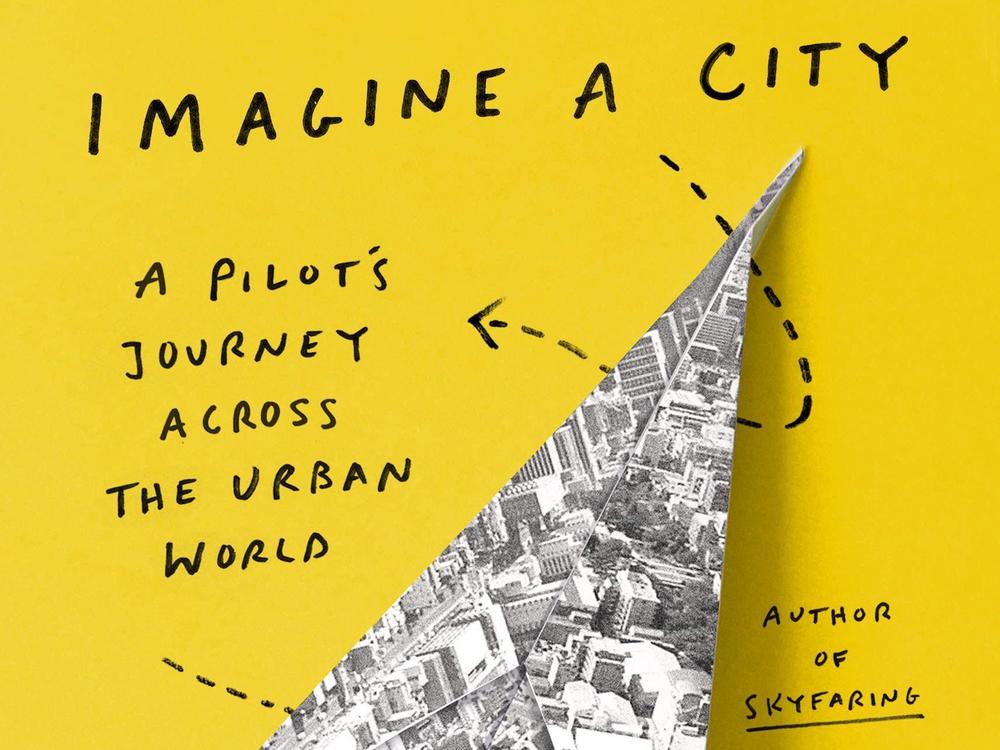Section Branding
Header Content
Flying around the world — and back home again — in 'Imagine a City'
Primary Content
Many people are taking to the skies this summer, planning exotic vacations after two-plus years of being largely grounded by the pandemic.
Even if you're not yet ready to brave crowded airports and long lines at TSA, you can still visit some of the world's great cities from the comfort of your armchair, with Mark Vanhoenacker as your tour guide.
Vanhoenacker, a commercial airline pilot, wrote lyrically in his previous book, Skyfaring, about the joys of soaring above the earth at the controls of a jumbo jet.
His new book, Imagine a City, moves from the journey to the destination — the far-flung places Vanhoenacker once dreamed about and now gets to see up close when the plane lands. The book also chronicles the author's own journey from lonely kid in western Massachusetts to confident globetrotter based in London.
Along the way, he takes us bicycling through Brasilia and birdwatching in Kuwait.
Like jet travel itself, the tour is sometimes disorienting. You go to bed reading a chapter about Jeddah and wake up to find yourself in Delhi. But Vanhoenacker is a sure-handed navigator, filling in the gaps with history, poetry, and lots of local color.
While he might lack the kind of insider's knowledge that comes from spending a lifetime in a city, Vanhoenacker has the benefit of making short but frequent visits to lots of places, with a pocketful of foreign currencies and a backpack brimming with curiosity.
He takes us traipsing through the snowy streets of Sapporo, Japan, and gliding over shipwrecks off the coast of Cape Town, South Africa — listening for the noontime cannon from the top of Signal Hill. (Or its social media equivalent: a daily tweet reading, "BANG!")
"I like to think that it's important for these worlds to be better connected," he writes. "Increasingly they are: by history and stories; by immigrants and travelers; by computers and — if it's not too prideful to say this — by airplanes."
Woven throughout the book are stories of Pittsfield, Mass., Vanhoenacker's boyhood home and the place he once dreamed of escaping. He'd sit in his bedroom, building model airplanes and imagining the distant places they could take him. He'd study the illuminated globe on his dresser, and sketch designs of a model metropolis, where a young man like himself might find a home.
"When I was young and struggling with being gay, and with my speech impediment, and with whatever else loomed large then, it felt almost lifesaving to be able to travel to my imaginary city, or to imagine myself in a real one that was sufficiently distant to feel safe," he writes.
While many people find liberation in the impersonal bustle of a big city, others sadly slip through the cracks. Vanhoenacker writes about spending layovers in San Francisco searching the anonymous streets for Henry, a family friend from Pittsfield, who'd fallen into drugs and despair.
"Henry's life has reminded me of what else it can mean to lose yourself in a city so far from your first one," he writes. "I'd be shaken to realize how easily I might forget to examine the faces of the middle-aged homeless men we passed."
The book was written in part during the pandemic, when so much air travel was temporarily grounded. For months, Vanhoenacker didn't fly anywhere. Some older pilots took early retirement while younger ones were laid off.
When flights resumed, they often carried more cargo than passengers: "pets, bags of letters, enough gold and pallets of banknotes to remind me that the world's financial system isn't yet entirely virtual, tens of tons of Scottish salmon, and medical supplies whose technical descriptions my colleagues and I would read out to each other from the cargo manifest with heightened interest and a new kind of pride."
Pandemic travel restrictions are fading now. The U.S. recently dropped its COVID testing requirement for international visitors and passengers are lining up to make long-delayed trips.
Vanhoenacker notes that historically, many great cities that once walled themselves off eventually became more welcoming:
"As cities grew — and survived thanks in part to their ramparts, into ages in which sieges and invasions were receding concerns — they have tended to take down their walls. The stones might have been useful for other structures, while the paths of demolished walls often became roads, especially ring roads."
Vanhoenacker compares the ring roads and railroads that circle Moscow and Berlin and Raleigh, North Carolina. He drives the last of these in his father's car, fondly known as the Minivanoenacker.
Another famous ring is made by Japan's Yamanote line, an elevated railroad that loops for 21 miles through central Tokyo and boasts six of the world's ten busiest train stations. Vanhoenacker gives readers a tour of all 30 stops, with names like "All-Day-Long Village" and "Sacred Rice Field."
When he pulls back into New Post Station, where he began the loop, Vanhoenacker knows better than to use the automatic turnstile. The fare-card reader might not recognize he'd gone anywhere at all.
By the end of the journey, the well-traveled author is back in Pittsfield, which he gratefully finds to be far more welcoming that he ever imagined growing up. Once again, he's come full circle.
Copyright 2022 NPR. To see more, visit https://www.npr.org.

